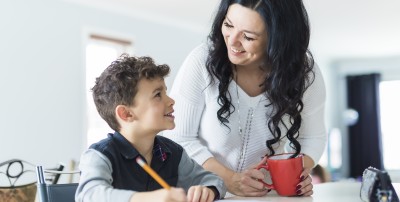
NOTE: The following information was published April 28, 2020. For current COVID-19 information, visit LVHN.org/COVID-19
The coronavirus (COVID-19) pandemic has disrupted life in many ways, causing disappointments and generating fear. There is worry about the health and safety of loved ones, about work, school, and getting groceries. Children often detect and embody the anxiety and fears of those around them.
Resiliency helps a child face challenges despite disappointment and worry. Where does it come from? It’s something learned over time. Parents and family members can help children develop and strengthen their resilience through emotional support, love and modeling basic techniques.
While providing reassurance, support and love to children during a crisis can go a long way to promote resiliency, parents need to know it isn’t something they can simply give to their kids. Resiliency is something children must accomplish for themselves. They need to be empowered with tools and tricks; they need a pathway to the other side of disappointment.
Pathway to resiliency
Sometimes parts of the pathway are fast, other times slow. Some parts may require a high level of reasoning and intellect, which is why an adult is an essential partner for a child experiencing disappointment and worry. This is especially true with external and complex crises like COVID-19.
The pathway includes 5 steps or stages: awareness, tolerance, reframing, self-determination and action. I call these steps: Yep, OK, See, Can and Do. As a pediatric oncologist I’ve seen a lot of disappointment and unfairness – and a lot of resilience. I’ve seen this pathway in action under some of the toughest circumstances.
Step 1: Yep
This first step is the acknowledgement and self-awareness that one is disappointed, worried and/or sad. Feeling negative emotions is natural. It’s the depth and breadth of those negative feelings that resiliency can minimize. Most children need someone to support them through this step, but eventually a child needs to learn how to do it on their own. Saying, “It’s OK to feel bad. This is hard. I understand,” is a good place to start.
Step 2: OK
The next step is accepting the situation, or better said, tolerating it. As parents, we’ve all seen children do this step very quickly and we’ve all seen them take a long time. The more attached or the more part of one’s identity something is, the harder it is to accept when it’s changed. The second step includes saying, “It will be OK. It happened. Let’s take a deep breath.”
Step 3: See
This stage is my favorite. Reframing a situation is so uniquely human and has resulted in so many wonderful things. It can be quick (the child runs off to play), or it can take a while (“Let’s do a project or plan a different vacation for this summer”). It can be simple (“Want to go for a walk?”), or it can be complex (long talks with an adolescent). It can be constructive (“Let’s share”), yet it can be destructive (“I think I’ll throw a fit”). Our role as parent, teacher or coach is to enable and empower this reframing by offering suggestions, modeling the way or sometimes just telling them new ways to think and possibilities to see. Children lack experience and thus perspective; our job is to help them see more than what they know.
Step 4: Can
This fourth step is about hope and optimism. Some call it a sense of self-efficacy or confidence. With external struggles, like the COVID-19 pandemic, hope often needs to come from parents and other adults helping the child understand and believe that we can and will overcome. Provide hope by saying, “We will get through this,” or “Things will be fine” or “We can do this.”
Step 5: Do
Taking action – doing – is often essential, and the faster one can get to it, the better. In fact, one ought not to seek perfection in the other steps, or get lost in them at the expense of putting off action. In most cases we help children with this intuitively, except when we’re frozen ourselves. The more resilient we are, the better able we are to help a child.
We can empower a child through this pathway by giving them unconditional love and support, by showing them possibilities and providing hope. Just knowing we’re there to help them and that we will pick them up when they fall keeps them moving along the resiliency pathway.
About the author
J. Nathan Hagstrom, MD, is Chair, Department of Pediatrics, with Lehigh Valley Reilly Children’s Hospital. Dr. Hagstrom is a board-certified pediatrician and pediatric hematologist oncologist. He is a champion for kids and for achieving excellence in children’s health care.
Stay informed about coronavirus (COVID-19) in our community by visiting LVHN.org/COVID19.
